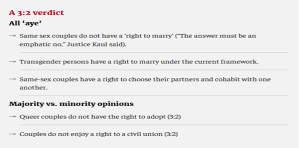TOPIC- ANALYSING THE SC VERDICT ON SAME-SEX MARRIAGE
THE CONTEXT: Recently, a five-judge Constitution bench headed by the Chief Justice of India has delivered its verdict on the issue of same sex marriage. The Court has taken some steps to protect same-sex unions from discrimination. But in the final analysis, the Court did not grant recognition to same-sex marriage and stated that there is no fundamental right to marry. This article analyses the judgement and its implications from the UPSC PERSPECTIVE.
A BRIEF OVERVIEW OF THE SUPRIYA CHAKRABORTY VS UNION OF INDIA CASE
- In the Supriya Chakraborty v Union of India case, petitions were filed for recognition of the right to marry and establish a family to sexual and gender minority individuals in India.
- The grounds cited by the petitioners were protections from discrimination, the right to equality, dignity, personal liberty, privacy, and personal autonomy, and freedom of conscience and expression.
- Chief Justice of India D.Y. Chandrachud and Justice Sanjay Kishan Kaul have ruled that queer couples have a right to seek recognition for their union but declined to read down the provisions of the Special Marriage Act to that effect.
- On the other hand, Justices S. Ravindra Bhat, Hima Kohli and P.S. Narasimha rejected the position, holding that any such recognition can only be based on statute.

- Hence, in the final verdict, a 3-2 majority favoured the refusal of legal recognition to unions other than heteronormative ones. The bench asserted that there is no fundamental right to marriage under the Indian Constitution.
- The Court upheld the Special Marriage Act, 1954 in its current form, e., permitting marriages only between a ‘man’ and a ‘woman’. It does not extend it to same-sex marriages.
- It upheld the institution of marriage flows from the statutes created by the state and the right to marry is not expressly recognized either as a fundamental or constitutional right under the Indian Constitution but a statutory right.
- The Court has accepted the government’s view that any move to legalise same-sex marriages will fall in the legislature’s domain.
- The Centre has been told to establish a high-powered committee under the Cabinet Secretary to consider the scheme of rights flowing from the civil union. This would range from opening joint bank accounts, same-sex spouses being a beneficiary for provident funds, pensions or inheritance to such spouses, among others.
MINORITY STAND
- Emphasis of individual liberty, dignity and choice: They argued that the legal recognition of civil unions for non-heterosexual couples represents a step towards marriage equality. They said that the right to form unions comes from the fundamental right to freedom of speech and expression, and the right to life. The minority view also said that with civil union status, same-sex couples must be extended the “bouquet of rights” that heterosexual couples are entitled to.
- Recognizing past injustices faced by the queer group and the state’s insensitivity: Majority stand, has highlighted the discrimination faced by queer group. The queer people exist across all communities and settlements, urban or rural and state is quite insensitive to address their concerns.
MAJORITY STAND
- Three judges of the five-judge Constitution bench disagreed with the Chief Justice of India on adoption rights for LGBTQIA people but agreed that the Special Marriage Act, 1956 (SMA) cannot be interpreted in such a manner so as to enable marriage between queer persons.
- Majority stated that the legislation regarding institution of marriage comes within the state power and only state has the power to frame such legislation by framing an independent structure for queers.
- The line between recognizing rights and overstepping boundaries: It is recognised that LGBTQ community faces discrimination from the state but declined acceptance on same-sex marriage. As such, a decision fell outside its purview and should be addressed by the Indian Parliament.
- Separation of Power: Majority opinion stated that striking down the SMA provisions would jeopardise the legal framework for interfaith and inter-caste couples. It was added that interpreting the SMA in a gender-neutral way would amount to “judicial lawmaking”, which would violate the doctrine of separation of powers.
THE HISTORICAL CONTEXT: PREVIOUS JUDGMENTS
NALSA CASE JUDGEMENT (2014)
- In the NALSA case judgement, the court held that transgenders fall within the purview of the Indian Constitution and thus are fully entitled to the rights guaranteed therein.
- The court made a distinction between biological sex and psychological sex. The judgment affirmed transgender people’s fundamental right to marry.
K. PUTTASWAMY V UNION OF INDIA (2017)
- It linked privacy with the rights of queer persons. In this judgement on Right to privacy, the Supreme Court held that sexual orientation of any individual comes under his/her Right to Privacy.
- This landmark judgement became the basis of declaring Sec 377 of IPC, under which Homosexuality was a crime, unconstitutional.
NAVTEJ SINGH JOHAR AND OTHERS V. UNION OF INDIA 2018
- In September 2018, a five-judge bench of the Supreme Court unanimously decriminalized consensual sex between two adults irrespective of their gender and partially struck down Section 377 of the IPC.
- The court referred to those areas of the section that criminalized consensual unnatural sex as “irrational, indefensible and manifestly arbitrary”.
- The SC held that members of the LGBTQ community “are entitled, as all other citizens, to the full range of constitutional rights including the liberties protected by the Constitution and are entitled to equal citizenship and equal protection of law.
- However, in its ruling, the court also made it clear that other aspects dealing with unnatural sex with animals and children still remained in force, and that it was confining its order to consenting acts between two adults.
SHAKTI VAHINI V. UNION OF INDIA (2018)
- A petition was filed under Art. 32 of the Indian Constitution to seek directions for the state governments as well as Central govt. to take necessary steps to prevent honour-related crimes.
- The SC recognized the right of two consenting adults to choose each other as partners in marriage to be a fundamental right under Arts. 19 and 21 of the Indian constitution.
- There is no requirement of consent of the family members, community or clan as a whole is not required.
THE RELEVANCE OF THIS CASE FOR THE INDIAN SOCIETY
- Large sections of Indian society are still opposed to the legalisation of same-sex marriages on religious and cultural grounds.
- People believe marriage is traditionally defined as a union between a man and a woman. According to society, altering this definition undermines traditional family values and the institution of marriage.
- Opponents argue that the primary purpose of marriage is procreation and raising children, and same-sex couples cannot fulfill this purpose. They believe children need both a mother and a father for a well-rounded upbringing.
- Same-sex marriage is seen as inconsistent with Indian cultural and religious beliefs by opponents. They fear legalizing it would erode traditional values and contribute to the Westernization of Indian culture.
- According to a survey titled ‘Politics and Society Between Elections 2019’ conducted by the Delhi-based think tank Centre for the Study Developing Societies (CSDS)-Lokniti in collaboration with Azim Premji University in Bengaluru. More than half of the respondents disapproved of recognition for same-sex relationships.
- The findings of the survey contradict popular perceptions about Indian acceptance of same-sex relationships as it was earlier thought as elitist and urban which comes out contradictory in survey. Nearly 59% of urban respondents said they did not want society to accept same-sex relationships in contraction to 53% of rural respondents. Also, at the same time, it is found that income does shape one’s opinion on same-sex relationships, but higher income doesn’t necessarily lead to a tilt towards acceptance.
- According to the survey, India’s minorities, in comparison to religious majorities, tend to strongly reject same-sex relationships. The religiosity in the state could be a link in defining their attitude towards such unions.
PUBLIC PERCEPTION AND MEDIA ROLE
- The survey found that increased media exposure leads to higher acceptance of same-sex relationships as media plays a key role in shaping opinion around LGBTQIA+,
- The findings also show that only 10 per cent of respondents with no media exposure tend to exhibit acceptance of same-sex relationships. The acceptance rate can go as high as 33 per cent for those with very high media exposure.

JURISPRUDENTIAL EXAMINATION FROM THREE PERSPECTIVES: LEGAL, MORAL, AND SOCIOLOGICAL
LEGAL
- The case has a legal angle attached to the judgement as the court has cited the limits of its jurisdiction and emphasised the legislative authority over such matters.
- There arises issue of violation of fundamental rights which is cited by petitioners that the exclusion of couples from sexual and gender minority communities from marriage laws constituted a violation of fundamental right. Similarly, the notice and objection provisions in secular marriage laws Special Marriage Act and Foreign Marriage Act constituted a violation.
- However, Jurisprudence of the courts interpreting constitutional provisions and including new rights in a liberal and expansive manner was not put into practice in this case.
- Hence, following Article 32 of the Indian Constitution, which guarantees the Right to Constitutional Remedies and designates the Supreme Court as the protector of Fundamental Rights, the petitioners argued that they are within their rights to approach the Supreme Court.
MORAL
- Another angle attached to the case is moral angle. Violating the rights of the queer community comes under the violation of the Universal Declaration of Human Rights (UDHR), of which India is a signatory.
- Even the Indian Constitution and courts have also been greatly influenced by the UDHR.
- Even in the Maneka Gandhi case, the Court relied on Article 10 of the UDHR to include principles of natural justice in the administrative process.
- In Navtej Johar Case (2018), CJI DY Chandrachud had held that “the Court has to be guided by the conception of constitutional morality and not by societal morality”.
SOCIOLOGICAL.
- The case tends to have societal impacts as it regulates relationships between people and prescribes behaviour patterns reflecting societal values.
- However, as the social realities change, the law changes. Also, sometimes a legal change precedes societal changes and is even intended to stimulate.
- Also, Article 15 of the Indian Constitution guarantees protection from discrimination. The Supreme Court extended the protection to include sexual orientation and gender identity.
- The Supreme Court itself has held that the choice of marital partner is an exercise of freedom of expression enshrined in Article 19 in Vikas Yadav v. State of Uttar Pradesh (2016), Asha Ranjan v. State of Bihar (2017), Shakti Vahini v. UOI (2018) and Shafin Jahan v Ashokan K.M. (2018).
- The SC said that unwarranted disclosure of the marriage plans might jeopardise the marriage and endanger the lives of the couple because of societal perception.
IMPLICATIONS OF THE JUDGEMENT FOR THE FUTURE
- Setback for the queer community: The ruling is a setback for India’s LGBTQ community. Many had expected the Supreme Court to grant them the right to marry their partners. As, in 2018 the supreme court scrapped a colonial-era law banning homosexuality in India, hope was this time for same sex marriage. While acceptance of homosexuality is growing, this judgement proves that Indian society still remains largely conservative. It is resistance to opening up marriage to same-sex couples, who still face rampant discrimination and harassment in society.
- Maintaining Status quo: There is no real meaningful application of the case as it keeps the status quo running with no important verdict. Beyond recognising natal family violence, it “doesn’t provide any real immediately actionable right to queer couples.
- No recognition in society: Marriage is indeed a social institution, with its own legal requirements and conditions for what constitutes a valid marriage. The right to seek social and legal validation through marriage is a matter of individual choice protected by the Constitution, but the Court still views it as being subject to statutory limitations.
- Formation of committee: The Court called on the Solicitor General’s submission that the government will constitute a committee, chaired by the Cabinet Secretary, to set out the benefits and entitlements for same-sex couples. It is to see whether the committee takes the right decision for ensuring the rights of the queer community.
- Less chance of legislation: Given that large sections of India may be opposed to the legalisation of same-sex marriages on religious and cultural grounds, the possibility of Parliament taking the initiative to do so is quite less. Also, States such as Andhra Pradesh, Assam, Gujarat, Madhya Pradesh and Rajasthan have opposed outright the legal recognition of same-sex marriages in the past. This judgment will only delay the already long and arduous struggle to create the conditions where same sex couples could live a life in freedom without fear.
THE WAY FORWARD
- Queer inclusive Policies: There is a need of proactive approach by law enforcement agencies by bringing in legal reforms. Inclusive approach for queer couples must be planned and adopted by the Government and society.
- Dialogue and Engagement: Engaging in a dialogue with religious leaders and communities can help bridge the gap between traditional beliefs and modern attitudes towards same-sex relationships. By working together, we can create a more inclusive society where everyone has the right to love and marry whomever they choose, regardless of their gender.
- Sensitization of authorities:There is a need of sensitization of authorities by creating awareness regarding equality of individuals irrespective of gender by modifying their behaviour and views. Change of approach of authorities can led to gender justice, equality and inclusion of queer community in the society.
- Granting recognition to marriage: It should be on the part of the legislature to frame adequate laws to grant recognition to the marriage of queer people. It is the duty of the State to extend necessary protection. It would signal a positive message and acceptance in society for queer people as well.
- Regulatory framework:There should be a separate anti-discrimination law and proper laws for punishment for the discriminatory practices against queer people to undo the historical injustice against the community as current laws are fragmented.
- Adoption regulation:Law on adoption should be on the basis of merit, not on sex. Merely because a relationship is regulated by law, it does not mean that couples who are not married are not serious about their relationship.
- Global recognition:A growing number of governments around the world are considering whether to grant legal recognition to same-sex marriages. India should also come forward to grant legal recognition for protection of their rights. State legislatures can enact laws recognising and regulating same-sex marriages; the Constitution under Articles 245 and 246 empowers both the Parliament and the State to enact marriage regulations. They need to create a gender-neutral law for marriage.
THE CONCLUSION: This verdict of the Supreme Court seems to have a significant impact on the queer community, and its significance lies in the broader trajectory of LGBTQ+ rights in India. The courts and the government have to come out and need to take steps for the larger good of marginalised communities as well. There is a need to create a more inclusive society by giving equal rights regardless of their gender.
MAINS QUESTIONS
Q.1 Queer community faces various challenges in Indian society. How far legalization of same sex marriage would address the discrimination faced by them? Analyse with respect to the impact of previous judgements of the Supreme Court.
Q.2 The Supreme Court’s recent unanimous verdict against legalizing same-sex marriage in India underscores the ongoing struggle for LGBTQ+ rights. Critically examine the implication of the judgement on the queer community.



